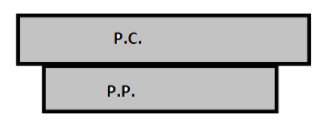Answer
437.1k+ views
Hint: An ecological pyramid represents the biomass or bio productivity at each trophic level in a given ecosystem. The inverted ecological pyramids mean producers are very small and have limited mass than primary consumers.
Complete answer:
This particular sort of ecological pyramid is an aquatic ecosystem on the basis of biomass. Here, each level takes into consideration the quantity of biomass produced by each trophic level. The pyramid of biomass is also upright except for that observed in oceans where large numbers of zooplanktons(primary consumer) depend on a relatively smaller number of phytoplankton(primary producer).
Phytoplankton are the primary producers in the marine ecosystem and are very small, even microscopic. These tiny organisms reproduce and die very quickly. So, at any given moment their biomass is comparatively less than the mass of the heterotrophs, like zooplanktons, fish and insects, albeit they provide energy for the whole ecosystem.
Additional Information:
A pyramid of biomass shows the connection between biomass and trophic level by quantifying the biomass present at each trophic level of an ecological community at a specific time. It's a graphical representation of biomass (total amount of living or organic matter in an ecosystem) present in the unit area in several trophic levels.
So, the right answer is ‘Pyramid of aquatic ecosystem on the basis of biomass’.
Note: A pyramid of numbers shows graphically the population, or abundance, in terms of the amount of individual organisms involved at each level during an organic phenomenon. A pyramid of energy or pyramid of productivity shows the assembly or turnover (the rate at which energy or mass is transferred from one trophic level to the next) of biomass at each trophic level.
Complete answer:
This particular sort of ecological pyramid is an aquatic ecosystem on the basis of biomass. Here, each level takes into consideration the quantity of biomass produced by each trophic level. The pyramid of biomass is also upright except for that observed in oceans where large numbers of zooplanktons(primary consumer) depend on a relatively smaller number of phytoplankton(primary producer).
Phytoplankton are the primary producers in the marine ecosystem and are very small, even microscopic. These tiny organisms reproduce and die very quickly. So, at any given moment their biomass is comparatively less than the mass of the heterotrophs, like zooplanktons, fish and insects, albeit they provide energy for the whole ecosystem.
Additional Information:
A pyramid of biomass shows the connection between biomass and trophic level by quantifying the biomass present at each trophic level of an ecological community at a specific time. It's a graphical representation of biomass (total amount of living or organic matter in an ecosystem) present in the unit area in several trophic levels.
So, the right answer is ‘Pyramid of aquatic ecosystem on the basis of biomass’.
Note: A pyramid of numbers shows graphically the population, or abundance, in terms of the amount of individual organisms involved at each level during an organic phenomenon. A pyramid of energy or pyramid of productivity shows the assembly or turnover (the rate at which energy or mass is transferred from one trophic level to the next) of biomass at each trophic level.
Recently Updated Pages
Mark and label the given geoinformation on the outline class 11 social science CBSE

When people say No pun intended what does that mea class 8 english CBSE

Name the states which share their boundary with Indias class 9 social science CBSE

Give an account of the Northern Plains of India class 9 social science CBSE

Change the following sentences into negative and interrogative class 10 english CBSE

Advantages and disadvantages of science

Trending doubts
Which are the Top 10 Largest Countries of the World?

Difference between Prokaryotic cell and Eukaryotic class 11 biology CBSE

Differentiate between homogeneous and heterogeneous class 12 chemistry CBSE

10 examples of evaporation in daily life with explanations

Fill the blanks with the suitable prepositions 1 The class 9 english CBSE

How do you graph the function fx 4x class 9 maths CBSE

The Equation xxx + 2 is Satisfied when x is Equal to Class 10 Maths

Difference Between Plant Cell and Animal Cell

What are the monomers and polymers of carbohydrate class 12 chemistry CBSE




